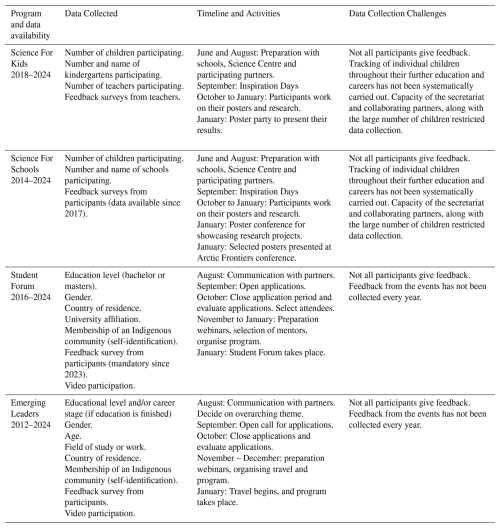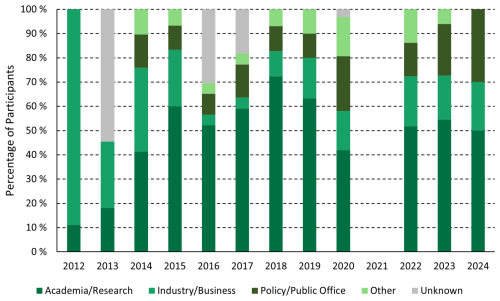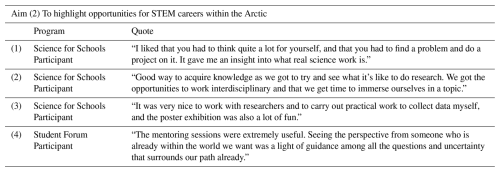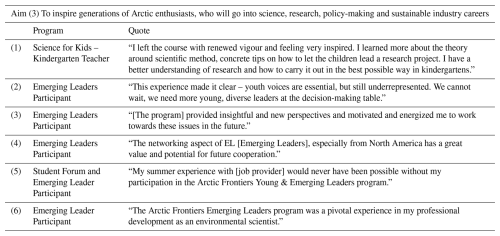the Creative Commons Attribution 4.0 License.
the Creative Commons Attribution 4.0 License.
From 5 to 35: fostering the next generation of Arctic scientists
Jenny V. Turton
Naima El bani Altuna
Charlotte Weber
Salve Dahle
Nina Boine Olsen
Elise Fosshaug
Katrine Opheim
Julia Morales-Aguirre
Astrid Wara
Out-of-classroom Education and Outreach initiatives can improve the uptake of Science, Technology, Engineering and Maths courses at higher education and can help address gender balances within the fields. Arctic Frontiers, a non-profit organisation based in Tromsø, Norway, has been running various projects under the Young Program banner since 2012. Through their four programs, ranging in levels from Kindergarten to Early Career Professionals (and ages from 5 to 35), over 3000 individuals have been exposed to Arctic research and science through workshops, mentoring, career seminars and excursions. With the rate of climate change in the Arctic and the geopolitical changes in the region, Education and Outreach initiatives focusing on Arctic science are now even more crucial, but potentially more challenging to run. This study evaluates the main educational activities and the best practices of the Arctic Frontiers Education and Outreach programs from the last decade, to highlight a number of possible programs which can be run in regions inside and outside of the Arctic. Additionally, a first analysis of the reach and success of the program is provided, by identifying trends in participant numbers, geographical interest and demographic identifiers. There has been an increase in participation across three of the four programs, including an increase in international participation and from those representing Arctic nations. Qualitative feedback from participants reveals that the programs are having a positive influence on their choice of Science Technology Engineering and Maths education or careers. Applications for the two programs with mentoring aspects are dominated by women, which reflects some of the current literature regarding women seeking formal mentorship for career development from areas outside of the Arctic.
- Article
(2714 KB) - Full-text XML
-
Supplement
(810 KB) - BibTeX
- EndNote
At both the education and career level, Science, Technology, Engineering and Maths (STEM) subjects are typically still characterised by an imbalance in gender and lack of minority groups across the globe (Gibney, 2016; Evagorou et al., 2024). Greater numbers of skilled and educated people (especially women) in STEM fields will benefit many nations which are struggling to find skilled workers, as well as increasing innovative potential and readdressing gender imbalances (Bøe et al., 2011).
The Arctic nations are no exception. In Norway, where more women are studying at university than men, only 30 % of full professor positions are held by women (Lekve and Gunnes, 2022). In Canada, only 4 % of Indigenous Peoples pursue an education in STEM (Cole et al., 2022). Therefore, there are still large inequalities in access to STEM education for minority groups, and a lack of support for women continuing their careers in academia (Pew Research Center, 2021).
In the Arctic and northern regions of the Arctic nations, there is an additional issue facing STEM fields. Out-migration of skilled workers to southern urban centres and capital cities (all located outside of the Arctic Circle) is a common trend across the Arctic (Nilsson and Larsen, 2020). We observe that Arctic science has a double “Leaky Pipeline” problem. The Leaky Pipeline is a common term to refer to individuals from under-represented communities who journey away from STEM education or careers due to pressures and inequalities in the field (Cole et al., 2022). In the Arctic, there is the additional leakage of highly skilled, young (often minoritised genders and ethnicities) people to the south. Therefore, it is crucial that young people residing in the north and the Arctic can develop an interest for, and skills in, STEM subjects, which make them highly employable and invested in remaining in the north.
In studies in the USA and Europe, it has been documented that out-of-school outreach projects lead to an increase in students' motivation to continue with STEM education and enhance their appreciation for STEM in real-life applications (Vennix et al., 2018; Baran et al., 2019; Neher-Asylbekov and Wagner, 2023). Consistent within the literature, is the knowledge that mentors and role models that reflect the students' identity (here, early-career, Indigenous or local northern residents), are key for increasing equality in the STEM fields (Kricorian et al., 2020; Cole et al., 2022). In Alaska, museums have been highlighted as crucial STEM outreach facilitators for Arctic youth. The retention of teachers in Alaska is poor: 60 % of Alaska's teachers leave the Arctic after just two years of teaching (Anderson et al., 2017). Out-of-school outreach provides informal learning and, when combined with industry visits or interactions, students feel more relaxed about learning complex subjects (Vennix et al., 2017). In addition, out-of-classroom activities can provide students the ability to see connections between schoolwork and careers or daily lives (Baran et al., 2019).
Scientists and researchers are now encouraged or required to engage in science communication and outreach as part of the requirements of funding agencies, due to the use of public money. However, non-academic research dissemination is often transient, ad-hoc or unsuccessful (Peters, 2024). Even scientists who actively highlight the importance and benefits of outreach and science communication for both the public and the science, are unlikely to engage in non-academic dissemination (Roberts, 2009). The burden and additional work for scientists to propose and organise their own outreach and science communication is large. This highlights the need for other organisations working at the forefront of science and local communities to provide the structure for scientists to engage with the public.
One such organisation is Arctic Frontiers: a private, non-profit organisation based in Tromsø (69.65° N, 18.96° E), Norway and owned by Akvaplan-niva, an aquaculture and environmental research and consultancy company. Arctic Frontiers aims to be a catalyst for decision-making and network-building within the Arctic and consists of a partnership of over 20 public and private institutions which include many universities and research institutions in Norway, as well as private companies with interests in the Arctic. Founded in 2007, Arctic Frontiers has been gathering Arctic stakeholders from science, business, politics, and local communities for discussions regarding a range of Arctic-relevant themes, such as climate change, geopolitics, energy transition and demographic changes. A number of Education and Outreach (E&O) projects, aimed at all ages between five and thirty-five, have been developed and run both nationally (in Norway) and internationally. With at least 10 years of experience in developing and implementing E&O activities through the Arctic Frontiers Young portfolio (hereafter, “Young Program”), and both qualitative and quantitative feedback, four key projects now feature in the annual running of Arctic Frontiers. An evaluation of the Young Program has been conducted, to assess the impact of the E&O programs and to provide an overview of improvements which can be made as the programs continue developing. The aims (A) of running a comprehensive Young Program are four-fold: (A1) to encourage a greater number of students to take further education in STEM subjects, (A2) to highlight opportunities for STEM careers within the Arctic, (A3) to inspire generations of Arctic enthusiasts, who will go into science, research, policy-making and sustainable industry careers, and (A4) to engage scientists in regular, impactful science communication with the public. The young program encompasses several age groups and educational stages, allowing participants to join the programs from kindergarten (age five) to early career level (age 35). This is contrary to many E&O programs which target specific groups and therefore this publication explores a wider age range than is typically seen in the literature (e.g one year group – Baran et al., 2019; secondary education – Vennix et al., 2017; early-years – Campbell et al., 2018). Therefore, the title reflects this wider audience.
To assess whether the E&O programs are meeting these aims, and to provide an insight into wider impact of the activities, the following research questions (RQ) are addressed in this paper: (RQ1) What are the trends in participation across age groups, countries and other demographic identifiers?, (RQ2) What indications are there that the E&O programs have positively influenced the interest in STEM education?, (RQ3) What evidence is there that the Young Program has impacted career choices of participants and their knowledge of career options, particularly in the Arctic?
The aim of the paper is to evaluate the significance of continued and sustained E&O projects at all stages of education and early career development, to provide an overview of possible activities, and to motivate others to conduct Arctic-related E&O projects also outside of the Arctic. The first section of the paper describes the various programs, including challenges and best practices for others wishing to engage in E&O programs, especially with harder-to-reach communities in the rural Arctic. The second part of the paper investigates the impact and reach of the four programs over the last decade, as well as a discussion on the limitations and future improvements.
The various young initiatives at Arctic Frontiers were developed since the beginning of the company in 2007 (Dahle et al., 2019), however funding difficulties meant that the activities were more consistent and structured after 2012, forming a complete Young Program. There are four key projects which occur annually as part of the Young Program (Fig. 1): Science for Kids, Science for Schools, Student Forum, and Emerging Leaders. These programs have been developed and improved over the years, and interannual changes reflect funding priorities, geopolitical circumstances, and evaluation of the program. The details of the standard programs are provided in detail below, however larger changes have occurred due to the COVID-19 pandemic and the Russian invasion of Ukraine. Therefore, between 2020 and 2024, some of the activities were suspended or altered due to the extenuating circumstances. Additionally, some information has been lost due to lack of consistent archiving practices prior to 2020, and GDPR regulation changes in 2018. Since 2021, a full archiving and reporting system is in place for competent monitoring of projects.
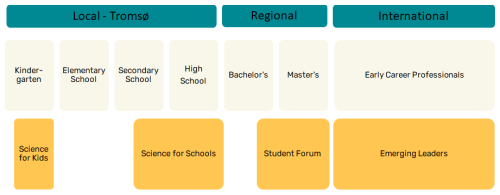
Figure 1Arctic Frontiers Young portfolio programs with respect to educational and professional development stages. Early career professionals includes PhD candidates and those in professional employment in industry, policy or public office.
All four projects within the Young Program are based on scientific knowledge and cognitive understanding as an educational approach to learning about the Arctic. This is the most common basis for climate change educational programs in a study of 220 publications focusing on E&O projects (Rousell and Cutter-Mackenzie-Knowles, 2019). The second most common educational approach is curriculum and pedagogy (Rousell and Cutter-Mackenzie-Knowles, 2019), which is the basis of the two programs with the youngest target audience at Arctic Frontiers (Table 1).
Table 1Summary of the Young Program components and the approaches taken for public E&O. The Educational Approach is based on the categories by Rousell and Cutter-Mackenzie-Knowles (2019).
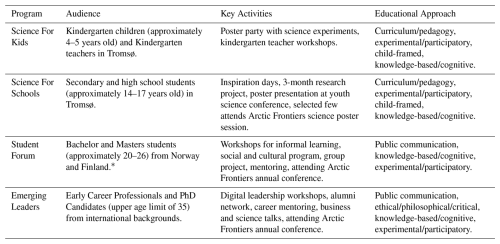
* 2022–2024 program was focused on students from Northern Norway and Finland, but this is dependent on funding.
2.1 Science For Kids
“Science for Kids” is the early-years project for children in the earliest years of formal education (here termed kindergarten for international translation), between the ages of four and five. This project is currently run in collaboration with the Science Centre of Northern Norway (Nordnorsk vitensenteret) and the UiT The Arctic University of Norway, Tromsø (UiT). The aim of this project is to initiate an interest in science, create positive associations with science, and to encourage the children to question the world in which they live. Furthermore, it is a goal to encourage the kindergarten teachers to run inquiry-based projects and to support them in building experience on how to guide children based on their curiosity for knowledge.
The project begins with Inspiration Days, where children visit the science centre to hear about how scientists study the ocean, atmosphere and ecosystem. This is an inquiry-based class, where the children's curiosity and exploration are encouraged. The kindergarten teachers are then invited to the Science Centre of Northern Norway for a course, where they are given skills, information and resources to lead the children in inquiry-based exploration about Arctic science. After a period of investigations carried out by the children, the Science Centre arranges a meeting with an expert, to provide support for the teachers in the kindergarten, and trigger further curiosity in the children. The children showcase posters of their research in a “poster festival”, which concludes with a science show from centre staff.
2.2 Science for Schools
The “Science for Schools” project is aimed at secondary and high school level (Fig. 1). The project has been running since 2014 and is organised in connection with the Science Centre of Northern Norway. The project aims to show pupils the steps of research, including deciding a hypothesis, conducting experiments and showcasing results via a conference.
Scientists are invited to provide engaging career and science talks as part of “Inspiration Days”. The aim is to initiate thought about which theme the pupils would like to investigate for their science project. For example, in 2022, speakers included marine biologists, meteorologists, aquaculture specialists, glaciologists and oceanographers.
Pupils then devise a hypothesis related to Arctic science (very broad in order for the pupils to investigate their main interests) and decide on a method or experiment to complete the research project with three months. To conclude, they create an A0 poster of their project, results, and conclusions. The final stage of the project is a three-day science conference, hosted at the Science Centre of Northern Norway, for the students to listen to oral talks from early career scientists, and they present their posters to a number of judges (Fig. 2). The judges are often master's students or PhD Candidates, so that they have the experience of evaluating scientific posters and providing constructive feedback to students. The format replicates an actual science conference, where oral talks, poster presentations and awards for presentations are provided.
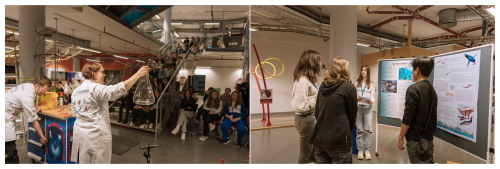
Figure 2High school students visit the Science Centre of Northern Norway and interact with scientists and educators (left). The school pupils present their posters to the judges during the Science For Schools program (right). Photo credit: Arctic Frontiers.
The awardees of the poster prizes are invited to present their poster at the Arctic Frontiers annual conference, as part of the science poster session. This allows the students to experience a scientific conference and interact with scientists. In 2022, pupils were also given an additional opportunity to visit the RV Kronprins Haakon, Norway's newest ice breaking research vessel, owned and operated by the Norwegian Polar Institute, Institute of Marine Research and UiT.
2.3 Arctic Frontiers Student Forum
The Arctic Frontiers Student Forum gathers Bachelor and Master students from various Arctic nations (depending on funding) for one week in Tromsø, to build a cross-border and cross-sectorial learning experience and networking arena. The group usually consists of approximately 15–20 students and the project has been running since 2016. Applicants are chosen based on the criteria that they must be students with an interest in learning more about the Arctic and sharing their Arctic experiences. Considerations for gender-balance and geographic diversity are also taken into account.
There are four aspects to the Student Forum: (1) Workshops for informal learning, (2) Social and cultural program, (3) Group project, (4) Mentoring. The theme of the informal learning workshops varies by year but topics have previously included the importance of science diplomacy, ocean preservation and management, mental health in the Arctic and climate change mitigation. The social and cultural program includes museum tours, art exhibitions, youth receptions and science communication evenings.
Students are asked to devise a question related to sustainable development of the Arctic which they will explore throughout the week and create a proposal for project funding to address the question, which they work on in groups. The mentoring part of the forum has two aspects: case guidance mentoring and career mentoring. The former should support the group projects, and the career mentoring aspect is more traditional mentoring, where students receive guidance on career options.
Since the beginning of the project, the shift from lecture-based to informal learning has taken place. The Student Forum now places emphasis on peer-to-peer learning, independent goal setting and projects (Table 1). The reason for this transition is two-fold: Firstly, through feedback and evaluation of participants over the years, it has become clear that students wanted the ability to learn from each other. Secondly, informal and peer learning techniques have been shown to promote interest and involvement of students notably in STEM fields (Goff et al., 2020; Roberts et al., 2018).
2.4 Emerging Leaders
Emerging Leaders is more of a mentoring and career development project than strictly E&O, however there are many aspects of this which overlap with E&O and also align with the aims of Arctic Frontiers to support Arctic scientists and professionals throughout the beginning of their career. The Emerging Leaders program evolved out of a former project called “The Young Scientist Forum”, run in connection with the Arctic Marine Ecosystem Research Network (ARCTOS), which took place in 2007. However, from 2012 onwards, these became two separate events.
The program sees approximately 30 PhD Candidates and Early Career Professionals each year travel through northern Norway in January and attend the Arctic Frontiers annual conference. This is an international program (see Table S1 in the Supplement), with over 15 countries participating in 2023. Participants must apply for the program in September, and a team of three evaluates the applications and selects candidates (see Supplement for criteria).
The selected participants meet in Bodø, northern Norway, embark on a 5 d travel and learning excursion via boat and bus across 530 km to Tromsø . Whilst travelling, participants meet a number of local business leaders, scientists and other professionals, for workshops, lectures and mentoring meetings, and peer-to-peer learning is incorporated. Since 2022, there has also been an alumni program developed, to allow the Emerging Leader participants to keep in touch with their peers and previous cohorts and digital workshops have regularly been offered.
3.1 Quantitative Data
The number of participants in each program, as well as certain demographic data (country of residence, age bracket, career level, gender) have been collected for some projects. The demographic data depends on the project and is largely a reflection of the funding agency requirements (e.g., requirement that a certain number of places are reserved for Arctic residents). Collection of data for the Student Forum and Emerging Leaders programs is also for evaluation of the applications, to ensure that those meeting the requirements of the program and the funding agencies are selected. The specific data collected is outlined in Table 2, along with the years in which the programs have been running
3.2 Qualitative Data
Feedback surveys following the programs and informal collection of opinions and reflections of the programs have provided the qualitative data. Feedback from the events has not been collected every year, and since 2021 the collection of data via surveys has been formalised and/or required for certain programs. This was due to the requirement of funding agencies and for the Arctic Frontiers secretariat to analyse the goals of the programs and improve the offerings to meet evolving student and young peoples' requests. All surveys are anonymous, and no demographic data are attached to the responses.
For the qualitative feedback from the Science for Kids and Science for Schools programs, the surveys were collected in paper, hand-written format and quotes were later digitized. The response rate has not been calculated but responses have been collected each year from 2017 to 2024. For the Emerging Leaders, surveys have been collected through an online software (Survey Monkey, https://www.surveymonkey.com, last access: 22 October 2025) since 2022, which is distributed after the program has concluded via email. The response rate since 2022 has been 52 % on average. No information on how many responded to the surveys or the method for survey collection prior to 2022 is available. For Student Forum, since 2023 surveys have been collected by software on the final day of the program, with an allotted time for the students to provide feedback, this has led to 100 % response rate for the last three years. Prior to this, no information is available on how many responded or which method the surveys were collected. From the surveys, videos and requests for feedback, the quotes have been combined and translated to English when necessary (see Table S2 for quotes).
A number of Student Forum and Emerging Leader participants were invited to participate in videos and provide oral feedback with their name/affiliation attached. This was not a requirement of those on the program and the public nature of the videos was made clear prior to participants before they were recorded. Student Forum and Emerging Leader participants consent to being recorded, photographed and documented prior to joining the program, and understand that their statements could be used publicly. Previous program participants can request to have their information or photographs and videos removed at any time.
3.3 Analysis of Qualitative Data
Sentiment analysis is often used to reveal the general positive, negative and neutral tone of quotes and opinions, and has widely been used to analyse social media posts (e.g., Scheibmeir and Malaiya, 2021). Sentiment analysis is sometimes referred to as “opinion mining” when used to identify intentions of those who respond to surveys or reviews and is can be used as a tool for analysis of students' opinions (Shaik et al., 2022). Analysis of sentiment and word frequency can be subjective. One must make a binary decision on whether a word is positive or not, the process can under-represent neutral words and oversimplify the intention (e.g., very good is more positive than good but is counted similarly). However, sentiment analysis can be used to provide the overall opinion of the group and to look at the ratio of positive to negative sentiments. We have used sentiment analysis on quotes from participants of the four programs in order to qualify the opinions of the program participants and used the WordNet lexicon dictionary (Princeton University, 2010) to define positive and negative words. Quotes which were provided in Norwegian have been translated to English, which may have led to a small number of words being misunderstood out of context. However, translation was as close to the original sentiment as possible.
The following section presents the results in line with the three Research Questions (RQs) outlined in Sect. 1.
4.1 Reach and Participation
In its latest phase (2023–2024), children from five kindergartens in Tromsø are gathered at the Science Centre as part of the Science for Kids project (Fig. 3). This project has seen a varied number of children participating (from 83 to 235). The number of kindergartens involved has fluctuated between five and thirteen since the program started in 2018. In total, over 1000 children and 90 kindergarten teachers have participated in the project. There was an increase in the number of children taking part in the program between 2018 and 2022, and an increase in the number of kindergartens involved in 2018 to 2020. However, the most recent years have seen a decrease in the number of both total children and kindergartens involved. The year with the highest number of children participating (2022) saw a large decrease in the total number of kindergartens. Fluctuations in number of children in particular age groups at kindergarten is responsible for this seeming discrepancy. Nevertheless, there was a decrease in individual kindergartens attending the program too. The number of kindergartens involved depends on available resources at the Science Centre and some kindergartens have withdrawn from the program, citing illness and staff shortages.
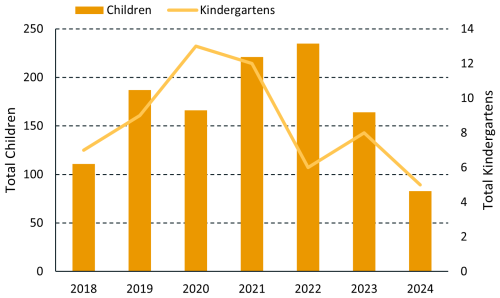
Figure 3The total number of participants in the Science for Kids program each year and the number of participating local kindergartens.
From 2022 to 2024, over 400 pupils from Tromsø have joined the Science for Schools Inspiration days from 5–8 different schools each year (Fig. 4). In most years, information on the number of pupils is available but not the number of schools, as students from smaller schools are combined on a number of the days. However, there has been an overall increase in the number of pupils and schools attending between 2015 and 2024, which has largely been attributed to greater visibility of the event within the local newspapers, broader networks of those involved in organising the event, and more consistent funding.
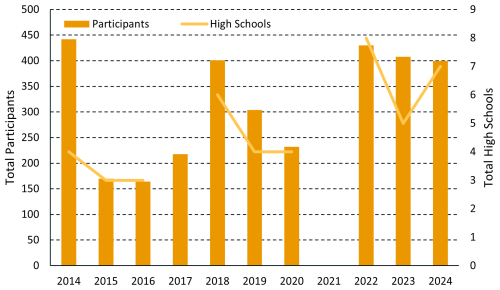
Figure 4The total number of participants in the Science for Schools program each year and the number of participating local high schools. COVID-19 meant that the project could not take place in 2021.
Scientists, especially Early Career Scientists (ECS) are incorporated into the Science for Kids and Science for Schools program systematically, through the “Inspiration Days” aspect (see Sect. 2). In the most recent years (2021 onwards), at least six scientists have been invited to speak with students and teachers each year, with many more asking for opportunities. ECS are also engaged to evaluate the student projects and posters, which provides additional science communication possibilities each year for another two scientists. From 2021 to 2024, 36 individual ECS have been involved in the Science for Schools program.
In addition, ECS and senior scientists are also engaged in the Student Forum program through mentoring the students and occasionally running workshops, although this varies each year depending on funding. In the Emerging Leaders program, PhD candidates and ECS who take part in the program are tasked with presenting their research and career highlights to their peers during the program, and select individuals are invited to speak at the Arctic Frontiers conference, to an audience of scientists, business leaders and Arctic experts.
The number of participants and the participating universities in the Student Forum program depends on the focus of the granted funding. In this particular project, an increasing number of students does not necessarily reflect the success of the program. In more recent years, the number of students each year has decreased (see Fig. 5), as the program has become more intensive, taken on a more structured format, is now better connected with the Arctic Frontiers annual conference, and has received varied funding. Additionally, in 2019 the program was adapted under the Barents Young Program which was largely supported by Russian institutions, and saw fewer overall students attending. Between 2016 and 2023, the Student Forum has connected over 140 students from across Russia and the Nordic countries, and provided mentoring, career development opportunities and out-of-classroom learning experiences.
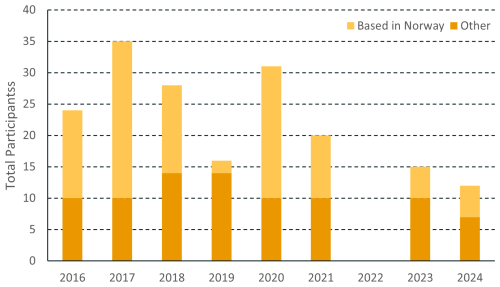
Figure 5The total number of participants in the Student Forum program each year divided by origin. Note that the program was not held in 2022 due to the suspension of financial collaboration between Norway and Russian institutes.
Since 2012, when the Emerging Leader program began, the annual cohort has increased from nine to a maximum of 33 in 2023. The total participant numbers, as well as gender balance and Arctic vs non-Arctic country split are presented in Fig. 6. The number of Indigenous peoples participating in Emerging Leaders has only been counted in the most recent years. Since 2022, Indigenous participants represented 12 %–13 % of the Emerging Leaders cohort. Whilst Arctic relevance is the main criteria for attending the Emerging Leaders program, Figs. 6b and 7 highlight the interest of non-Arctic nations in attending the program. The majority of those from non-Arctic nations are PhD Candidates or researchers who are focusing on the Arctic in their research. The percentage of non-Arctic nations attending each year has decreased relative to Arctic nations. This is partly due to the funding for approximately 15 spaces (roughly half of the annual cohort) being ring-fenced for those from Canada and Norway. The total number of attendees each year has been between 25 and 30 for the last 7 years (excluding 2021 due to COVID19). This is seen as the maximum size which allows for good connections within the group and logistically possible for travel along the remote Arctic coast.
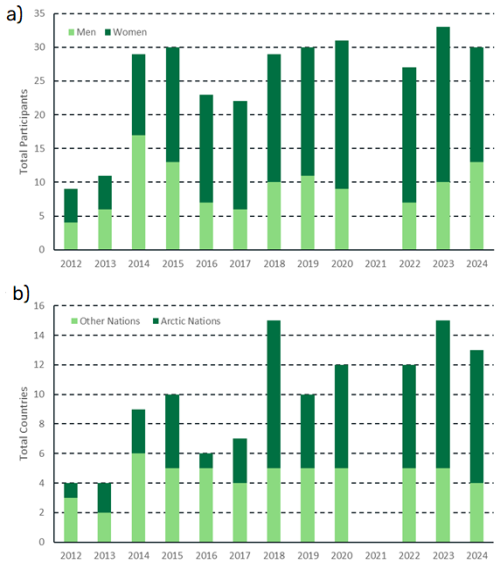
Figure 6(a) The total number of participants in the Emerging Leaders program each year, split by gender. Gender was in some cases assumed from name and photograph, as gender information was not collected for all years. (b) The total number of countries represented in each Emerging Leader program (where the individual is residing, not their nationality), split into non-Arctic and Arctic countries. In 2021, the program was run online with participants from the previous five years due to COVID19 restrictions. In 2012 and 2013, records were incomplete, with information on participant gender and affiliation for just 9 people in each year.
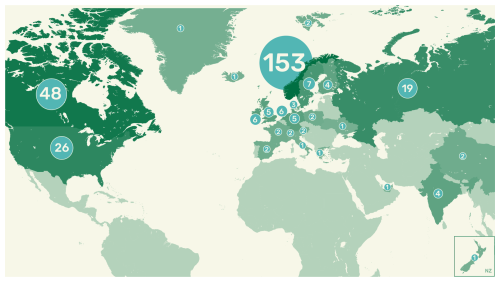
Figure 7Graphical representation of the country of residence of all known Emerging Leaders between 2012 and 2024 (location when they applied for the program). Figure created by Reibo AS graphic design company.
The diversity of participants in the Student Forum and Emerging Leaders programs has increased over the years, due to a specific effort of the secretariat to consider diversity in the evaluation of applications and due to increased marketing to hard-to-reach communities. The Emerging Leaders program strives for diverse participants in terms of gender (Fig. 6a), country of residence (Fig. 7, Table S1), profession and when all other factors are similar, prioritising Indigenous Peoples and Arctic residents. In addition, many funding agencies now require that a certain portion of the funding is provided to Indigenous, northern or Arctic residents (e.g funding received from Global Affairs Canada). The Student Forum participants are more restricted by country- or region-specific funding however, the international aspect of the program has remained though, with over half of the students affiliated to universities outside of Norway (Fig. 5). Whilst specific demographic data are not collected, Indigenous peoples have always been encouraged to apply to Student Forum, and for the last three years, participation has increased through the inclusion of the Sámi University of Applied Sciences in the program.
The number of Emerging Leaders participants identifying as women has fluctuated between 41 % in 2014 and 74 % in 2022 (Fig. 6a). Both the number of applicants and selected participants has been dominated by people identifying as women since 2015. The higher percentage of participants identifying as women is a reflection of the significantly higher number of women than men applying to the program.
Whilst those in academia and research (including PhD Candidates) dominate the annual cohort of Emerging Leaders in all years since 2014, the number of participants who work in policy and business sectors has been increasing since 2020 (Fig. 8). Since 2023, an anonymous feedback survey has been sent to the participants. Whilst only two years of data are available, the average score for satisfaction of the variety of the program' was 86/100 in 2023 and 71/100 in 2024. The decrease in satisfaction in 2024 was not related directly to the program, but instead a reflection of extreme weather causing last-minute changes to the logistics. Storms along the northern coast of Norway meant that boats and flights were cancelled and hotels fully booked due to stranded travellers. This was seen by some as a negative on the whole experience.
4.2 Interest in STEM Education
Qualitative data from participants of the earliest phases of the Young Program and Student Forum is presented in Tables 3 and S2. Students and teachers were not directly asked what impact the program has had on their educational path. Feedback questions have been largely dictated by funding requirements or to allow the project to be evaluated (and then improved). Therefore, there are many additional quotes which focus on other aspects of the program than the four aims (see Table S2).
A kindergarten teacher (quote 1, Table 3) confirms a positive interest in science from the pupils who attended. In addition, some students mention the impact that attending the program had on their study choice (quote 2 and 4, Table 3) or thoughts about the process of research (quote 3, Table 3).
Table 3A selection of quotes from participants of the Young Programs which mention the interest in STEM subjects (A1).
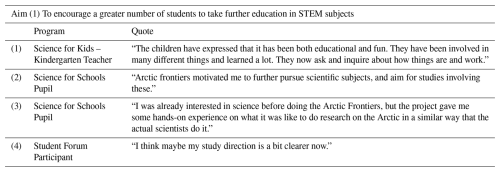
Sentiment analysis of the quotes from all programs revealed positive words (e.g., good, amazing, interesting etc.) were counted 111 times compared to 5 negative words (e.g., boring, disappointed, bored etc). The word cloud (Fig. 9) showcases many of these positive sentiments of the young participants. Non-emotive words (e.g., different, people and work) dominate the frequency of words used, and upon further analysis the word “different” is often used to reflect the backgrounds and opinions of people the participants interacted with. Whilst diversity of opinions is not an aim of the program, it is a key aspect of understanding Arctic peoples.
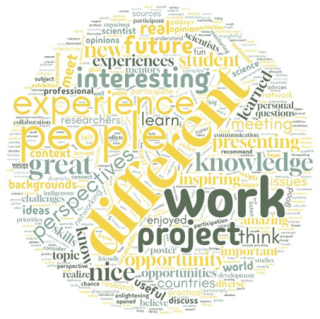
Figure 9Word cloud (generated by https://wordclouds.com, last access: 23 June 2025) to reflect the frequency of words collected in the quotes from participants of the four programs.
4.3 Careers in STEM
With the connection between STEM education and STEM careers, RQ3 asks: What evidence is there that the Young Program has impacted career choices of participants and their knowledge of career options, particularly in the Arctic?
From analysis of qualitative data, there is an increased understanding of what a career in STEM is like in reality (e.g., quote 3, Table 4) and a connection between attending the program and a future job opportunity is made in quotes 5 and 6 of Table 5.
Upon analysis of all quotes, words specifically connected to career outcomes, future prospects and thought production are mentioned 154 times (see Table S2 for quotes). These words include opportunities, learned, research, collaboration, education etc. (see Supplement for full list). Many of these words are repeatedly mentioned, for example “opportunity” or “opportunities” is said by 10 participants. The importance and appreciation of the mentoring aspect of the Student Forum and Emerging Leaders programs is highlighted seven times by the participants, and “networking” is mentioned six times. The word cloud (Fig. 9) highlights the high frequency with which career-related words were quoted by participants, as the words with the highest frequencies are presented largest on the figure. Some participants focused on the networking aspect of the programs, and said they still interacted and met with their cohort at other conferences and work events (see Supplement Table S2). The word “network” (or networking) was mentioned by six different participants, and the importance of “meeting people” (or similar constructions) was highlighted by nine people. The mentoring aspects of both Student Forum and Emerging Leaders were also consistently mentioned in a positive light.
Table 6Quotes from the participating kindergarten teachers in Science for Kids. These quotes are translated from Norwegian into English, and therefore not direct quotes.

The qualitative feedback from the kindergarten teachers also reflects an additional positive impact of the programs on the careers of the teachers through enhanced scientific understanding and increased integration of new knowledge into the classroom (Table 6).
Integrating more high-quality education into the classroom at an early age has been shown to have a positive impact in later life in numerous countries (Campbell et al., 2018). In addition, McClure et al. (2017) reported that early-years teachers in the US require more training on how to engage young children in STEM and need advice on how to counteract anxieties and negative attitudes towards STEM subjects. With the particular problem of retention of teachers in the Arctic, as reported in Alaska by Anderson et al. (2017) and reflected in Arctic Canada (e.g., Lewthwaite and McMillan, 2007) and across the Nordics (Nordic Teachers' Organizations Consultation, 2023), it is vital to better prepare and support teachers in STEM.
The Arctic Frontiers Young Program fosters the next generation of scientists with a passion for Arctic issues, from the age of 5 to 35, through the four programs: Science for Kids, Science for Schools, Student Forum, and Emerging Leaders. Over 3000 individuals have passed through the Young Program since its inception in 2012. To provide a first analysis of the Young Program, and to identify areas of continued improvement, assessment of the participation trends and evaluation of qualitative feedback from participants has been conducted.
5.1 Shifting Trends
The number of participants and applicants in the two international programs aimed at ages between 18 and 35 (Student Forum and Emerging Leaders) have increased over time, and the diversity of participants in terms of gender, country of residence, Indigenous or minority indicators and profession has also broadened to include a variety of voices.
However, the last few years have been characterised by significantly higher numbers of women than men applying to participate, and measurably higher quality applications coming from women too (applications are evaluated anonymously, with no information to identify the participants disclosed to the selection committees). This is then reflected in the selected participants (e.g., Fig. 6). Similarly, despite funding to support the inclusion of 8–10 participants from Norwegian universities in the Emerging Leaders program, the vast majority of those who apply are international students living in Norway, rather than Norwegian nationals. Whilst there is limited research looking into these aspects, some parallels can be drawn from studies which identify gender and nationality gaps in internship work, networking and mentoring programs.
Despite some progress being made in addressing the issues of representation of women and minorities in STEM education, progress has been slow and insufficient (Evagorou et al., 2024). Mickey (2022) identified that women in the technology profession typically seek out formal networking and mentoring events, conferences and seminars, to engage in more “strategic networking” than men, who tend to use “strategic socializing” by building informal networks through social events and sports. Mentoring and networking were highly appreciated aspects of the Student Forum and Emerging Leaders programs, with frequent mentions of them within the qualitative data. Demographic data were not connected to the answers of the feedback surveys; therefore we are not able to investigate whether male or female attendees focused more heavily on the mentoring and networking side of the programs.
Over-representation of women in unpaid internships compared to men have been found in a number of studies in the USA and Canada (Crain, 2016; NACE, 2019; Hora et al., 2022) and attributed to the normalization of low wages for the work that women do (Shade and Jacobson, 2015). Similarly, a wage gap exists between white American young people and first-generation immigrants or international students in the internship and apprenticeship fields too (Hora et al., 2022). A recent journalistic investigation of the Norwegian University of Science and Technology (NTNU) identified that just 10.8 % of applicants to 43 advertised PhD positions (in the field of sustainability) were Norwegian citizens (Vartdal, 2022). Upon interviewing the Rector of the university, Professor Tor Grande, he expressed that many young Norwegians are employed in jobs following their bachelor's or master's degrees due to competitive labour markets (Vartdal, 2022). This fact could also reflect the reduced number of Norwegian nationals joining the Student Forum and Emerging Leaders programs, despite a high number of Norwegian institutions participating. In a recent study “Polar Peoples” which investigates demographic and migration trends in the Arctic, the Norwegian county of Troms (in which Tromsø sits) had experienced an opposing trend to most other Arctic regions: a growth in population of 13.6 % between 1990 and 2018. Only 1.6 % of this growth was attributed to net-migration, with the rest due to the positive difference between births and deaths (Heleniak, 2020). With a small contribution of growth due to migration, it is then surprising that so many of the participants of the programs are not Norwegian citizens. However, as our programs focus heavily on students and specifically those related to STEM, the Young Program likely interacts with international students rather than the general population living in the Norwegian Arctic. With very different demographic trends across the Arctic, and complicated by the location of the Young Programs in Tromsø – a growing urban centre in the Arctic, it is difficult to say whether the demographics of participants in these programs is a reflection of other E&O STEM-focused programs.
It is challenging to secure Norwegian-speaking scientists to present their science and career developments. Partly, this could be attributed to the high number of international PhD Candidates and Post Doctoral researchers in Norway, as outlined by Vartdal (2022). Therefore, the scientists who provide the Inspiration Days talks for Science for Schools often participate for a number of years, which provides some stability to the program but does have a negative impact on how many early career students have the opportunity to participate. Other English-speaking science communication opportunities are provided for those who want to be involved in the education and outreach programs, when possible. A4 is therefore being met, but has room for improvement, as the number of participants has remained relatively constant over time.
With over four million Indigenous Peoples in the Arctic, representing almost 9 % of the Arctic's population, it is important to include young Indigenous Peoples in the E&O programs. The Student Forum and Emerging Leaders programs have both historically included participants who self-identify as belonging to an Indigenous community, however demographical records are only available recently. Since 2022, Indigenous participants represented 12 %–13 % of Emerging Leaders participants, which is a larger representation than the 9 % of Arctic's population who are Indigenous. The Student Forum program also includes students studying at the Sámi University of Applied Sciences in Guovdageaidnu/Kautokeino, Norway. The high level of engagement amongst Indigenous communities follows a concerted effort by the Arctic Frontiers team to engage with Indigenous, remote and harder to reach communities. Specific marketing of the programs is targeted to different countries, and there are options for simplified application forms to accommodate digital infrastructure difficulties in some remote locations. Indigenous mentors are engaged in the Student Forum and Emerging Leaders programs. Several studies have identified that E&O programs which recruit minorities and women in mentoring positions, has a positive impact on the uptake of STEM subjects by those who relate to the minority mentors (e.g. Krikorian et al., 2020; Cole et al., 2022). In this case, Indigenous community members and those who live and work in the high-northern regions are important to showcase opportunities for those taking part in the programs. Active communication with several Indigenous organisations is continually ongoing to improve the diversity of the programs and ensure that the programs reflect the needs of the various communities within the Arctic. Feedback from project partners and collaborators has highlighted that the timing of the call for applications and activities can be a barrier to small and Indigenous communities, who have limited capacity and additional responsibilities in combination with their job and/or studies, such as harvesting, reindeer herding and hunting. Informal discussions with community members in the Yukon, Canada, have highlighted that the deadline for Emerging Leaders coincides with hunting and harvesting season in northern Canada, meaning eligible Canadian citizens (both First Nation and non-indigenous locals) are not able to prioritise applying for the program. Due to the wildfires in northern Canada during the 2024 Emerging Leaders application phase, a deadline extension was provided to those coming from affected areas. One potential way of increasing the accessibility of the program is to introduce flexible deadlines.
Ruesch and Sarvary (2024) investigated the impact of a two-tier, flexible deadline approach in assignment deadlines for students. In this case, an “ideal” deadline and an “extendable-without penalties” deadline were communicated to students. The results suggest that there was no negative impact on student grades (Ruesch and Sarvary, 2024). Whilst this is a different situation than a university, a flexible deadline approach could be considered for future participants.
5.2 Impact on STEM Education and Careers
Participation trends alone do not provide evidence that the Young Program is succeeding with A1. However, analysis of other indicators such as the sentiment of participants (RQ2) reveals that the Science for Kids and Science for Schools programs are increasing the interest of STEM education. Many participants reflected on a greater interest in STEM and reflection on their studies and influence on their future plans (See Table S2 for Quotes). Qualitative feedback from discussions with teachers and students have revealed that participants are inspired by the program and do decide to take STEM subjects at university level (Table 2). A number of quotes show that students reflected on the methods of teaching within the program, with a more relaxed atmosphere, out-of-classroom approach and opportunities to meet with their peers. This reflects results from Vennix et al. (2017), who found a relationship between students wanting to study within the STEM fields and feeling a more positive association to the topics. Words such as “interesting”, “enlightening” and “fun” were common (21 times in total) amongst the quotes from the younger participants. In addition, the Science for Schools program allows the students to lead and develop their own research program, which provides a level of autonomy over the project. Some students specifically pointed to the poster creation, presentations of their work and investigations they undertook. Autonomy and decision-making regarding E&O projects were also an important factor for students in the USA and the Netherlands in the study by Vennix et al. (2017). Similarly, inquiry-based or hands-on activities as part of E&O programs was important for continued interest in STEM by students in Germany (Neher-Asylbekov and Wagner, 2023).
Similar to RQ2, to answer RQ3 we analysed the qualitative feedback of the participants, particularly of the Student Forum and Emerging Leaders programs, in order to assess A2 and A3. Students who provided feedback (see the Supplement) reflected that they had a greater understanding of STEM and developed their professional skills early in their career after participating in the Student Forum program. The networking and mentoring aspects of both Student Forum and Emerging Leaders were also mentioned in a positive light 13 times. Informal professional networks can have meaningful impacts on those entering careers in STEM. Xu and Martin (2011) identified that although particularly meaningful for women in academic jobs, professional networks can be beneficial to all genders, and that attending conferences is a way of establishing networks. Maintaining networks can be particularly useful for accessing information and resources, support and friendship (especially for women) and providing collaboration opportunities (Xu and Martin, 2011). The alumni network of the Emerging Leaders program was established in 2022 and provides an easy tool for the past participants to maintain and further develop their network. This is a closed LinkedIn group, which was selected as the optimal platform for correspondence by the previous participants in a survey. This alumni network could serve as a useful data collection method in the future.
Active tracking of the educational and career choices of the participants of the Science for Schools and Student Forum programs has not taken place. With limited capacity within the Arctic Frontiers secretariat, plus within the organisations such as museums and schools which collaborate on the programs, it is difficult to continue communication with a high number of individuals, especially children. The most active monitoring of careers is with the Emerging Leaders, due to dedicated funding and efforts to establish the alumni network. From informal contact with previous participants of both Student Forum and Emerging Leaders, many report that they have continued their careers in STEM following the programs, however the exact figures are not collected.
5.3 Program Limitations
There are several ways in which more data can be collected in the future, to gain a better understanding of the impact of the young programs. A project has been initiated with UiT, to better understand the role of the E&O projects for younger participants (Science for Schools) and surveys will be designed with child development experts to ascertain the potential impact of early STEM visibility in their career paths. Similarly, the Emerging Leader and Student Forum alumni could be engaged further to greater understand the role that the programs have had on their future decisions. With over a decade since the first programs, information could be collected on both the immediate and long-term impacts of the programs on their careers, networks and professional skill development.
E&O programs face a number of difficulties, especially those conducted in remote places such as the Arctic, which is inhabited by varied communities with different needs, interests and languages. There are barriers and limitations to the programs which reduce the attractiveness to many, including Indigenous Peoples. The applications for Student Forum and Emerging Leaders must be submitted in English, as the working language of Arctic Frontiers is English, and the majority of events take place during the annual international conference, which is an English-language conference. This is also a necessity due to the international mixture of the participants and mentors. However, whilst the proficiency of the English language is particularly high in the Nordic countries (Bonnet, 2004), to enhance engagement, advertising of the programs and application forms in different Arctic languages could be considered, however the program will likely remain in English due to the internationality.
The Science for Kids program is conducted fully in Norwegian, and the Science for Schools program is a mixture between English and Norwegian depending on the requirements of the schools (Norwegian public schools and an International School are included). However, the students selected to present at the Arctic Frontiers conference are expected to present their work in English, both in written (poster) and oral format. This is a limitation to the program and can be a barrier or discomfort for the pupils, which actively works against some of the objectives of the program (to inspire and encourage greater interest in STEM and Arctic subjects). The Inspiration Days talks from scientists are largely conducted in Norwegian – at the request of many public schools whose pupils find it difficult to have a scientific lecture in an alternative language to their mother tongue and main language at school.
5.4 The Future of Funding
The programs are negatively impacted by the short-running cycle of many funding sources for such activities. Most of the funding for the programs require an annual application and funding covers just one cycle of the program (e.g., Student Forum), and longer funding periods still require new applications each third year (e.g., Science for Schools). Limitations in public funding also hinder the success of projects. Science for Schools is impacted by teacher availability and funding. Some schools have communicated the importance of this project in their annual curriculum, and pupils from these schools present their research each year. For other schools, attendance is dependent on the availability of teachers and the interest of pupils in extra-curricular groups. The Emerging Leaders program is particularly vulnerable to funding changes, as the project is the costliest to run and only half of the spaces on the program are supported through funding sourced by Arctic Frontiers. Short-lived funding additionally effects the capacity of the Arctic Frontiers Secretariat, as few funding agencies provide money for salaries of those organising the programs. This is not a unique problem. In a study of 48 STEM programs, Rincon and George-Jackson (2014) identified that low staffing rates and lack of long-term stability of projects due to frequent funding reductions had a negative impact on the ability of the programs to function.
Here we have presented the first analysis of the four components of the Arctic Frontiers Young Program, with a focus on trends of participants (number, geographical reach, gender, demographics) over the last decade, as well as gathering feedback from participants. To assess the impact of the Young Program, three Research Questions (RQ) have been addressed: (RQ1) What are the trends in participation across age groups, countries and other demographic identifiers?, (RQ2) What indications are there that the E&O programs have positively influenced the interest in STEM education?, (RQ3) What evidence is there that the Young Program has impacted career choices of participants and their knowledge of career options, particularly in the Arctic?.
We reported an increased number of applications and participation for the Student Forum and Emerging Leaders program, as well as consistently high numbers of children taking part in the two earlier-years activities. For Student Forum, the percentage of non-Norwegian participants has increased since the program widened from a bilateral focus to a multi-national focus. For the Emerging Leaders program, which has always accepted participants from any country, the split between non-Arctic nations and Arctic nations has transitioned to Arctic-nation dominated since 2018. This could suggest that aims of the program (to highlight opportunities for STEM careers within the Arctic, and to inspire generations of Arctic enthusiasts, who will go into science, research, policy-making and sustainable industry careers) are being met, with more opportunities for those living and working in the Arctic.
Quantitative monitoring of participants entering study programs/careers in STEM following participation in the programs is not undertaken – a current limitation of the programs, which also inhibits the analysis of how well aim 1 (A1) to encourage a greater number of students to take further education in STEM subjects) is being met. Qualitative feedback from participants does however point to increased interest in Arctic and/or STEM fields, as well as the programs having a positive influence on their future decisions (Tables 3 and 4).
Aspects of the Arctic Frontiers Young Program have been running since 2012, which has fostered new generations of Arctic enthusiasts and scientists. Qualitative feedback from the participants of Emerging Leaders and Student Forum points to increased interest in STEM subjects and continuing education and/or careers in STEM fields. Contrary to most studies looking at the connection between E&O studies and STEM education or careers, the applications for two activities are dominated by women. A hypothesis for this trend is that young women may be more likely to seek formal mentoring possibilities, and both the Student Forum and Emerging Leaders programs include a mentoring aspect. Many of the participants for the two older-group programs also include many international students and young professionals. A high rate of engaged international students in Norway may not be representative of the Arctic as a whole, as until 2023 education in Norway was free for international students. Since the fall of 2023, students coming from outside of the EU/European Economic Area must now pay for their higher education in Norway. Whether this change will be reflected in either the Young Program participants or STEM statistics in the Norwegian Arctic in general is yet to be seen.
With changes in company structure and staff and differing reporting requirements depending on the funding source, demographic data and monitoring of participants was patchy until recently. Going forward, demographic data and the long-term impacts of the Young Program will be collected and analysed, to further improve the diversity and inclusivity of the project. The continuation of the Young Program is heavily dependent on accessible funding. Short term funding, and funds which only cover 50 % of the total costs or includes funding only for travel and project activities, but does not allocate staffing costs, are limitations to the program. Additionally, international E&O programs and the funding which supports them, are impacted by geopolitical challenges. Long-term funding for E&O programs should be provided by more sources, such as national research councils, to ensure the continued support of out-of-classroom learning experiences for young people in all education stages.
Data are not avaible publically. Data have been collected over a number of years and those who participated did not give approval for their quotes and feedback to be available publically. The information is sensitive and contains affiliations of universities and businesses where the participants work and study. In addition, data from children and vulnerable groups were collected and we do not have approval for public storage of the data. The data that are available for public use are all listed in the supplement. The data are available upon request, after a discuss around what the data will be used for and in which manner.
The supplement related to this article is available online at https://doi.org/10.5194/gc-8-339-2025-supplement.
Development and structure of the study was a joint effort between all authors. Data collection and quantitative analysis for the Science for Kids and Science for Schools programs was coordinated and conducted by E.F., A.W. and N.B.O. Data collection and analysis for the Emerging Leaders program was conducted by J.M.A. and C.W. Figures were created by J.V.T. and J.M.A. Data collection and quantitative analysis of the Student Forum program was conducted by K.O. and N.E.A. Sentiment analysis and development research questions were conducted by J.V.T. Literature and background to the study was led by S.D. Section 2.1 and 2.2 were written by E.F., A.W. and N.B.O. The manuscript was prepared by J.V.T. with input, amendments and specifics provided by all other authors.
The following authors work for Arctic Frontiers: Jenny V. Turton, Katrine Opheim, Julia Morales-Aguirre.
All quotes were received voluntarily through feedback surveys, videos and interviews. For public feedback, participants were asked for prior consent before recording. For feedback from surveys, quotes were anonymous, and all quotes have been anonymised for analysis in this publication.
Whilst engaging with Indigenous peoples, we adhered to many written principles, e.g., from the Inuit Circumpolar Council (https://iccalaska.org/wp-icc/wp-content/uploads/2022/06/EEE-Protocols-LR-1.pdf?fbclid=IwAR2p7Ki5YclD3Grc2P-H8UFsI3dJaJ1WJ2cooziiRGY7UAF_Cw88qanY_Og, last access: 22 October 2025) and Sámi Council (https://www.saamicouncil.net/news-archive/co-creating-research-projects-some-personal-experiences-from-saami-council-and-arctic-researchers, last access: 22 October 2025) including clear communication, valuing Indigenous knowledge, and building and maintaining relationships. In Norway, IRB approval is not a formal requirement and therefore it was not requested. There are national advisory boards, but they do not grant approval. However, all data were and continue to be treated confidentially, and no demographic data were attached to survey responses. We adhered to GDPR rules, have not named any individuals, and all participants at the education and outreach activities have signed a consent form that states that we could store and use their data. No participants received money to answer the surveys or take part in data collection.
Publisher's note: Copernicus Publications remains neutral with regard to jurisdictional claims made in the text, published maps, institutional affiliations, or any other geographical representation in this paper. While Copernicus Publications makes every effort to include appropriate place names, the final responsibility lies with the authors. Views expressed in the text are those of the authors and do not necessarily reflect the views of the publisher.
This article is part of the special issue “Climate and ocean education and communication: practice, ethics, and urgency”. It is not associated with a conference.
Arctic Frontiers is a non-profit organisation which relies on project funding for continuation of the programs. The authors would like to thank the Partner organisations of Arctic Frontiers, as well as funding from Research Council of Norway, Sparebank Nord Norge, Global Affairs Canada, Erasmus + Active Youth, the Norwegian Barents Secretariat and the work of the Science Centre of Northern Norway. We also acknowledge the support of the Ursa Major project 322317, funded by the Research Council of Norway. The Young Program has been improved and developed over many years, by different stakeholders and especially the Young Program Coordinators. The authors thank all of those who have influenced the development of the program or carried out the projects.
The project was partially funded by Ursa Major project 322317, funded by the Research Council of Norway.
This paper was edited by Solmaz Mohadjer and Berill Blair and reviewed by Siri Veland and three anonymous referees.
Anderson, K. L., Kaden, U., Druckenmiller, P. S., Fowell, S., Spangler, M. A., Huettmann, F., and Ickert-Bond, S. M.: Arctic science education using public museum collections from the University of Alaska Museum: an evolving and expanding landscape, Arctic Science, 3, 635–653, https://doi.org/10.1139/AS-2017-0010, 2017.
Baran, E., Canbazoglu Bilici, S., Mesutoglu, C., and Ocak, C.: The Impact of an out-of-school STEM education program on students' attitudes toward STEM and STEM careers, Integrated STEM Education, https://doi.org/10.1111/ssm.12330, 2019.
Bonnet, G.: The assessment of pupil's skills in English in eight European countries 2002, The European Network of Policy Makers for The Evaluation Of Educational Systems, European Network of Policy Makers for the Evaluation of Education Systems, https://web.archive.org/web/20240111162734/https://www.educacionyfp.gob.es/inee/dam/jcr:d426c134-5c58-44f0-8641-3b5e4354ed37/habilidadesingles2002-1.pdf (last access: 28 October 2025), 2004.
Bøe, M. V., Henriksen, E. K., Lyons, T., and Schreiner, C.: Participation in science and technology: young people's achievement-related choices in late-modern societies, Studies in Science Education, 47, 37–72, https://doi.org/10.1080/03057267.2011.549621, 2011.
Campbell, C., Speldewinde, C., Howitt, C., and MacDonald, A.: STEM Practice in the Early Years, Creative Education, 9, 11–25, https://doi.org/10.4236/ce.2018.91002, 2018.
Cole, L., Goodyer, J., and Ironside, V.: k2i academy: An Innovative Ecosystem Addressing System Barriers in STEM from Kindergarten to Industry. Proceedings of the Canadian Engineering Education Association (CEEA), https://doi.org/10.24908/pceea.vi.15876, 2022.
Crain, A.: Understanding the Impact of Unpaid Internships on College Student Career Development and Employment Outcomes, National Association of Colleges and Employers, NACE Foundation, https://www.naceweb.org/uploadedFiles/files/2016/guide/the-impact-of-unpaid-internships-on-career-development.pdf (last access: 28 October 2025), 2016.
Dahle, S., Lindefjeld, O., and Brekke, P.: Emerging Leaders, ISBN 978-82-691319-0-1, 2019.
Evagorou, M., Puig, B., Bayram, D., and Janeckova, H.: Addressing the gender gap in STEM education across educational levels – Analytical Report, European Commission: Directorate-General for Education, Youth, Sport and Culture, Publications Office of the European Union, https://doi.org/10.2766/260477, 2024.
Gibney, E.: Women Under-Represented in World's Science Academies, Nature, https://doi.org/10.1038/nature.2016.19465, 2016.
Goff, E. E., Mulvey, K. L., Irvin, M. J., and Hartstone-Rose, A.: The effects of prior informal science and math experiences on undergraduate STEM identity, Research in Science & Technological Education, 38, 272–288, https://doi.org/10.1080/02635143.2019.1627307, 2020.
Heleniak, T.: Poplar Peoples in the Future: Projections of the Arctic Populations, NORDREGIO Working Paper 2020:3, https://doi.org/10.6027/WP2020:3.1403-2511, 2020.
Hora, M., Jang-Tucci, K., and Zhang, J.: Gatekeeping at work: a multi-dimensional analysis of student, institutional, and employer characteristics associated with unpaid internships. Centre for Research on College-Workforce Transitions, https://ccwt.wisc.edu/wp-content/uploads/2022/11/Unpaid-Internships_Hora-Jang-Tucci-Zhang_Nov-2022.pdf (last access: 22 October 2025), 2022.
Kricorian, K., Seu, M., Lopez, D., Ureta, E., and Equils, O.: Factors influencing participation of underrepresented students in STEM fields: matched mentors and mindsets, IJ STEM Ed., 7, 16, https://doi.org/10.1186/s40594-020-00219-2, 2020.
Lekve, K., and Gunnes, H.: Gender Balance in Norwegian Academia: Present State and Future Scenarios, Frontiers in Education, 7, https://doi.org/10.3389/feduc.2022.809116, 2022.
Lewthwaite, B. and McMillan, B.: Combining the Views of Both Worlds: Perceived Constraints and Contributors to Achieving Aspirations for Science Education in Qikiqtani, Can. J. Sci. Math. Techn., 7, 355–376, https://doi.org/10.1080/14926150709556740, 2007.
McClure, E. R., Guernsey, L., Clements, D. H., Bales, S. N., Nichols, J., Kendall-Taylor, N., and Levine, M. H.: STEM starts early: Grounding science, technology, engineering, and math education in early childhood. New York: The Joan Ganz Cooney Center at Sesame Workshop, https://files.eric.ed.gov/fulltext/ED574402.pdf (last access: 22 October 2025), 2017.
Mickey, E. L.: The Organization of Networking and Gender Inequality in the New Economy: Evidence from the Tech Industry, Work and Occupations, 49, 383–420, https://doi.org/10.1177/07308884221102134, 2022.
NACE (National Association of Colleges and Employers): The 2019 Student Survey Report: Attitudes and Preferences of Associate Degree Students, https://www.naceweb.org/uploadedFiles/files/2019/publication/executive-summary/2019-nace-student-survey-two-year-executive-summary.pdf (last access: 22 October 2025), 2019.
Neher-Asylbekov, S. and Wagner, I.: Effects of Out-of-School STEM Learning Environments on Student Interest: a Critical Systematic Literature Review, Journal for STEM Educ. Res., 6, 1–44, https://doi.org/10.1007/s41979-022-00080-8, 2023.
Nilsson, A. E. and Larsen, J. N.: Making Regional Sense of Global Sustainable Development Indicators for the Arctic, Sustainability, 12, 1027, https://doi.org/10.3390/su12031027, 2020.
Nordic Teachers' Organizations Consultation: Teacher shortage in the Nordic countries Comparing the current situation, NLS, https://www.csee-etuce.org/images/Reports/Teacher_shortage_NLS-report_22.11.2023.pdf, last access: November 2023.
Peters, C.: Children's books for research-based outreach and science communication pedagogy, Geoscience Communication, 7, 81–90, 2024.
Pew Research Center: STEM jobs see uneven progress in increasing gender, racial and ethnic diversity, https://www.pewresearch.org/wp-content/uploads/sites/20/2021/03/PS_2021.04.01_diversity-in-STEM_REPORT.pdf (last access: 22 October 2025), 2021.
Princeton University: About WordNet, WordNet, Princeton University, https://wordnet.princeton.edu/ (last access: 22 October 2025), 2010.
Rincon, B. and George-Jackson, C.: STEM Intervention Programs: Funding Practices and Challenges, Studies in Higher Education, 41, 429–444, https://doi.org/10.1080/03075079.2014.927845, 2014.
Roberts, M. R.: Realizing Societal Benefit from Academic Research: Analysis of the National Science Foundation's Broader Impacts Criterion, Social Epistemology, 23, 199–219, https://doi.org/10.1080/02691720903364035, 2009.
Roberts, T., Jackson, C., Mohr-Schroeder, M. J., Bush, S. B., Maiorca, C., Cavalcanti, M., Schroeder, D. C., Delaney, A., Putnam, L., and Cremeans, C.: Students' perceptions of STEM learning after participating in a summer informal learning experience, IJ STEM Ed., 5, 35, https://doi.org/10.1186/s40594-018-0133-4, 2018.
Rousell, D. and Cutter-Mackenzie-Knowles, A.: A systematic review of climate change education: giving children and young people a “voice” and a “hand” in redressing climate change, Children's Geographies, 18, 191–208, https://doi.org/10.1080/14733285.2019.1614532, 2019.
Ruesch, J. M. and Sarvary, M. A.: Structure and Flexibility: Systemic and Explicit Assignment Extensions Foster an Inclusive Learning Environment, Frontiers in Education, 9, 1324506, https://doi.org/10.3389/feduc.2024.1324506, 2024.
Scheibmeir, J. A. and Malaiya, Y. K.: Social Media Analytics of the Internet of Things, Discover Internet of Things, Brief Communication, 1, https://doi.org/10.1007/s43926-021-00016-5, 2021.
Shade, L. R. and Jacobson, J.: Hungry for the Job: Gender, Unpaid Internships, and the Creative Industries, The Sociological Review, 63, 188–205, https://doi.org/10.1111/1467-954X.12249, 2015.
Shaik, T., Tao, X., Dann, C., Xie, H., Li, Y., and Galligan, L.: Sentiment analysis and opinion mining on educational data: A survey, Natural Language Processing Journal, 2, https://doi.org/10.1016/j.nlp.2022.100003, 2022.
Vartdal, R.: 90 prosent av søkerne til nye NTNU-stillinger bosatt utenfor Norge, Khrono News Paper Article, https://www.khrono.no/90-prosent-av-sokerne-til-nye-ntnu-stillinger-bosatt-utenfor-norge/666514 (last access: 22 October 2025), 2022.
Vennix, J., den Brok, P., and Taconis, R.: Perceptions of STEM-based outreach learning activities in secondary education, Learning Environ. Res., 20, 21–46, https://doi.org/10.1007/s10984-016-9217-6, 2017.
Vennix, J., den Brok, P., and Taconis, R.: Do Outreach Activities in Secondary STEM Education Motivate Students and Improve Their Attitudes towards STEM?”, International Journal of Science Education, 40, 1263–1283, https://doi.org/10.1080/09500693.2018.1473659, 2018.
Xu, Y. J. and Martin, C. L.: Gender Differences in STEM Disciplines: From the Aspects of Informal Professional Networking and Faculty Career Development, Gender Issues, 28, 134–154, https://doi.org/10.1007/s12147-011-9104-5, 2011.





